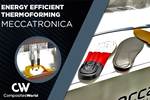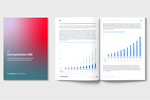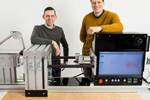TPRC announces press forming dataset publication
Recent research by academia aimed to validate composite forming simulations for press forming UD thermoplastic composite laminates.
Source | Dennis Brands
PhD researcher Dennis Brands, part of the University of Twente (UT, Enschede, Netherlands) ThermoPlastic Composites Research Center (TPRC), recently published a dataset with press forming results for unidirectional (UD) thermoplastic composite laminates.
The dataset was designed for the validation of composite forming simulations, featuring high-resolution, in-plane deformation measurements and clear wrinkling observations. An accompanying dataset description article was published in the journal Data in Brief, which provides all the relevant details of the experimental and analysis methodologies used. The dataset encourages discussion on the material behavior during press forming and offers the potential to benchmark numerical simulations.
According to the abstract, “Truncated hemisphere parts were press formed with two commercially available unidirectional thermoplastic composite materials, namely Toray TC1225 and Solvay APC. The width and layup of the laminates were varied to influence the wrinkling severity, to trigger various deformation mechanisms and to influence the amount of in-plane deformation. A total of eight layup/width combinations were selected and formed in triplicate for both materials, resulting in the analysis of 48 parts in total.”
This dataset and description was published with open access as part of TPRC’s “Press forming without defects” (PERFECT) project, led by close collaboration with Václav VomáÄŤko from the Technical University of Liberec (Czechia) and together with Sebastiaan Wijskamp, Wouter Grouve and the Production Technology research group of Remko Akkerman at the University of Twente. The NWO (Nederlandse organisatie voor Wetenschappelijk Onderzoek) provided project funding.
Read about the dataset .
Related Content
-
The potential for thermoplastic composite nacelles
Collins Aerospace draws on global team, decades of experience to demonstrate large, curved AFP and welded structures for the next generation of aircraft.
-
Update: THOR project for industrialized, recyclable thermoplastic composite tanks for hydrogen storage
A look into the tape/liner materials, LATW/recycling processes, design software and new equipment toward commercialization of Type 4.5 tanks.
-
Eaton developing carbon-reinforced PEKK to replace aluminum in aircraft air ducts
3D printable material will meet ESD, flammability and other requirements to allow for flexible manufacturing of ducts, without tooling needed today.






